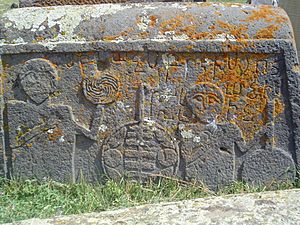Noraduz cemetery facts for kids
The Noraduz cemetery is a very old cemetery in the village of Noraduz, Armenia. It is famous for its many ancient stone crosses called khachkars. This special place is near Lake Sevan, about 90 kilometers (56 miles) north of Yerevan, the capital city. Many of the tombstones here have beautiful carvings that show scenes from weddings and farm life.
What are Khachkars?
Khachkars are unique Armenian cross-stones. They are carved stones, usually with a cross in the middle. The cross is often surrounded by other patterns like suns or plants. These stones are a very important part of Armenian art and history.
The oldest khachkars in Noraduz cemetery date back to the late 10th century. This means they are over 1,000 years old! The art of carving khachkars became very popular again in the 16th and 17th centuries. During this time, Armenian artists created many new khachkars. Some famous carvers like Kiram Kazmogh (who lived from 1551 to 1610), Arakel, and Meliset created beautiful khachkars right here in Noraduz.
A Clever Story from History
There is a popular folktale about the Noraduz cemetery and a famous invader named Tamerlane. The story says that Tamerlane's army was planning to attack the village. To trick the invaders, the villagers had a clever idea. They placed helmets on top of the khachkars and leaned swords against them.
From a distance, the khachkars looked exactly like a large army of soldiers ready to fight. Tamerlane's army saw this "army" and thought the village was too strong to attack. Because of this clever trick, Tamerlane's army decided to retreat and left the village alone.
Images for kids
See also
 In Spanish: Cementerio de Noraduz para niños
In Spanish: Cementerio de Noraduz para niños









